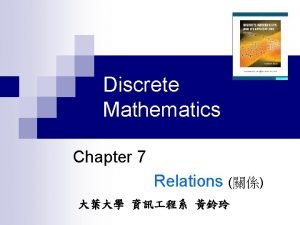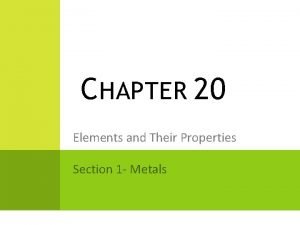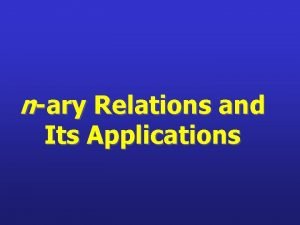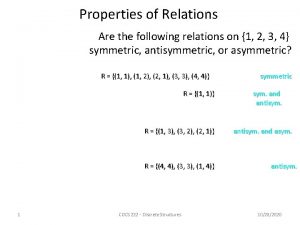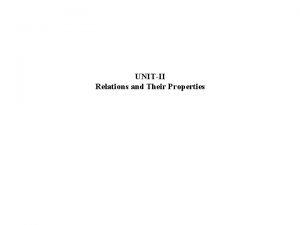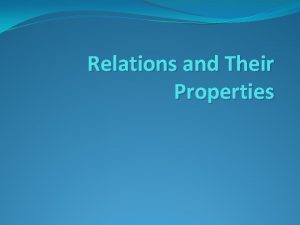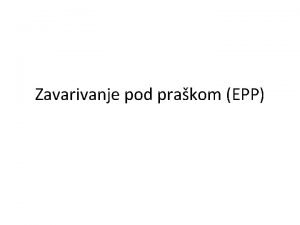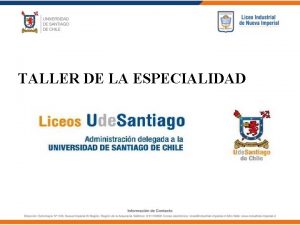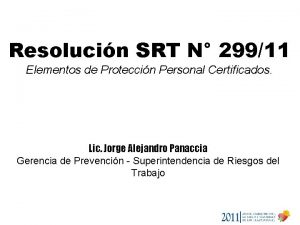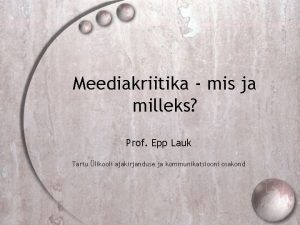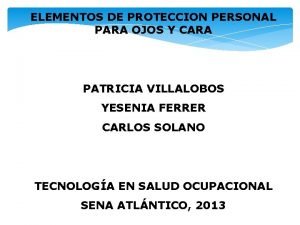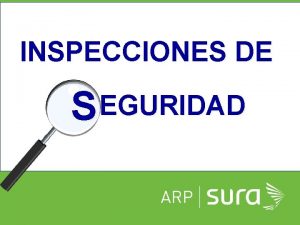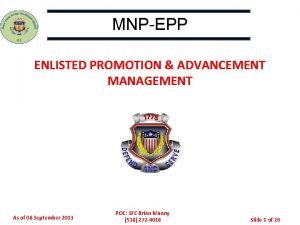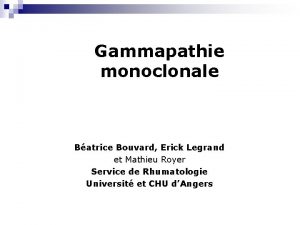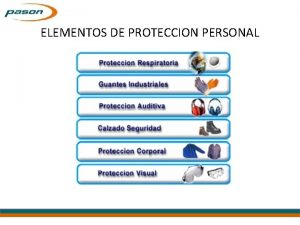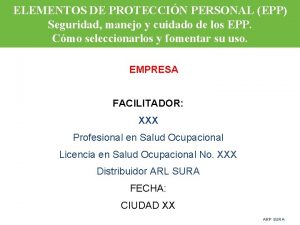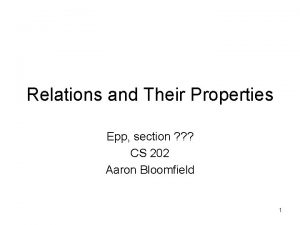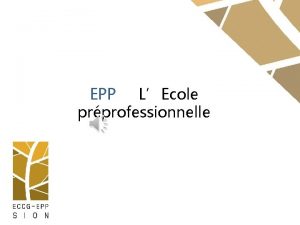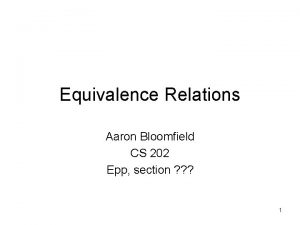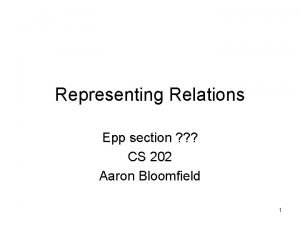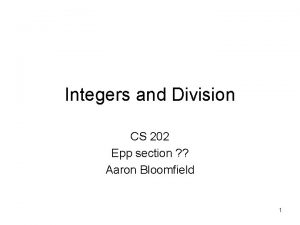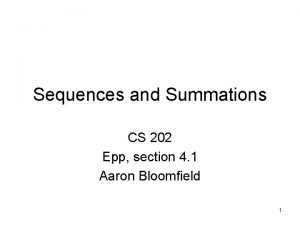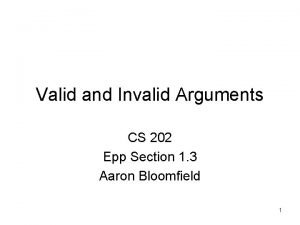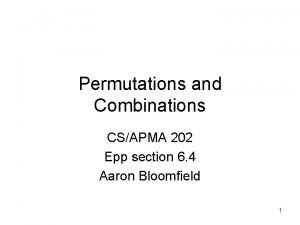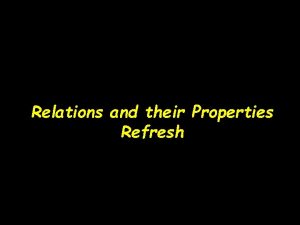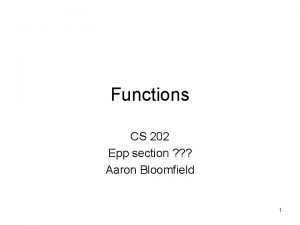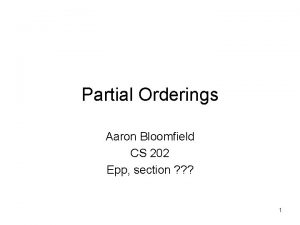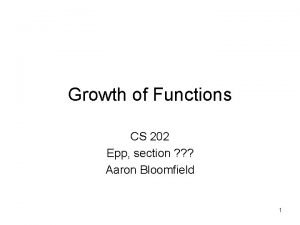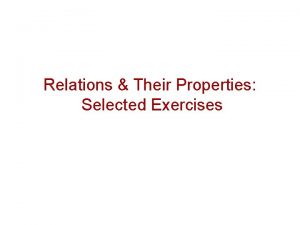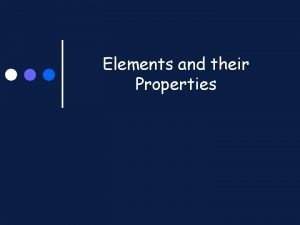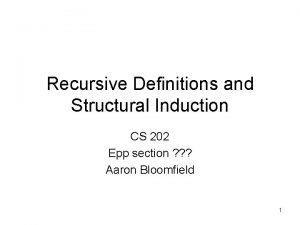Relations and Their Properties Epp section CS 202

























- Slides: 25

Relations and Their Properties Epp, section ? ? ? CS 202 Aaron Bloomfield 1

What is a relation • Let A and B be sets. A binary relation R is a subset of A B • Example – Let A be the students in a the CS major • A = {Alice, Bob, Claire, Dan} – Let B be the courses the department offers • B = {CS 101, CS 202} – We specify relation R = A B as the set that lists all students a A enrolled in class b B – R = { (Alice, CS 101), (Bob, CS 202), (Dan, CS 201), (Dan, CS 202) } 2

More relation examples • Another relation example: – – Let A be the cities in the US Let B be the states in the US We define R to mean a is a city in state b Thus, the following are in our relation: • • • (C’ville, VA) (Philadelphia, PA) (Portland, MA) (Portland, OR) etc… • Most relations we will see deal with ordered pairs of integers 3

Representing relations We can represent relations graphically: We can represent relations in a table: CS 101 Alice Bob CS 201 Claire CS 202 CS 201 CS 202 X X X Claire Dan Not valid functions! 4

Relations vs. functions • Not all relations are functions • But consider the following function: a 1 b 2 c 3 d 4 • All functions are relations! 5

When to use which? • A function is used when you need to obtain a SINGLE result for any element in the domain – Example: sin, cos, tan • A relation is when there are multiple mappings between the domain and the co-domain – Example: students enrolled in multiple courses 6

Relations on a set • A relation on the set A is a relation from A to A – In other words, the domain and co-domain are the same set – We will generally be studying relations of this type 7

Relations on a set • Let A be the set { 1, 2, 3, 4 } • Which ordered pairs are in the relation R = { (a, b) | a divides b } • R = { (1, 1), (1, 2), (1, 3), (1, 4), (2, 2), (2, 4), (3, 3), (4, 4) } 1 1 2 2 3 3 4 4 R 1 1 X X 2 3 4 2 3 X 4 X X X 8

More examples • Consider some relations on the set Z • Are the following ordered pairs in the relation? (1, 1) (1, 2) (2, 1) (1, -1) (2, 2) • • • R 1 = { (a, b) | a≤b } R 2 = { (a, b) | a>b } R 3 = { (a, b) | a=|b| } R 4 = { (a, b) | a=b } R 5 = { (a, b) | a=b+1 } R 6 = { (a, b) | a+b≤ 3 } X X X X 9

Relation properties • Six properties of relations we will study: – – – Reflexive Irreflexive Symmetric Asymmetric Antisymmetric Transitive 10

Reflexivity • A relation is reflexive if every element is related to itself – Or, (a, a) R • Examples of reflexive relations: – =, ≤, ≥ • Examples of relations that are not reflexive: – <, > 11

Irreflexivity • A relation is irreflexive if every element is not related to itself – Or, (a, a) R – Irreflexivity is the opposite of reflexivity • Examples of irreflexive relations: – <, > • Examples of relations that are not irreflexive: – =, ≤, ≥ 12

Reflexivity vs. Irreflexivity • A relation can be neither reflexive nor irreflexive – Some elements are related to themselves, others are not • We will see an example of this later on 13

Symmetry • A relation is symmetric if, for every (a, b) R, then (b, a) R • Examples of symmetric relations: – =, is. Twin. Of() • Examples of relations that are not symmetric: – <, >, ≤, ≥ 14

Asymmetry • A relation is asymmetric if, for every (a, b) R, then (b, a) R – Asymmetry is the opposite of symmetry • Examples of asymmetric relations: – <, > • Examples of relations that are not asymmetric: – =, is. Twin. Of(), ≤, ≥ 15

Antisymmetry • A relation is antisymmetric if, for every (a, b) R, then (b, a) R is true only when a=b – Antisymmetry is not the opposite of symmetry • Examples of antisymmetric relations: – =, ≤, ≥ • Examples of relations that are not antisymmetric: – <, >, is. Twin. Of() 16

Notes on *symmetric relations • A relation can asymmetric be neither symmetric or – R = { (a, b) | a=|b| } – This is not symmetric • -4 is not related to itself – This is not asymmetric • 4 is related to itself – Note that it is antisymmetric 17

Transitivity • A relation is transitive if, for every (a, b) R and (b, c) R, then (a, c) R • If a < b and b < c, then a < c – Thus, < is transitive • If a = b and b = c, then a = c – Thus, = is transitive 18

Transitivity examples • Consider is. Ancestor. Of() – Let Alice be Bob’s parent, and Bob be Claire’s parent – Thus, Alice is an ancestor of Bob, and Bob is an ancestor of Claire – Thus, Alice is an ancestor of Claire – Thus, is. Ancestor. Of() is a transitive relation • Consider is. Parent. Of() – – Let Alice be Bob’s parent, and Bob be Claire’s parent Thus, Alice is a parent of Bob, and Bob is a parent of Claire However, Alice is not a parent of Claire Thus, is. Parent. Of() is not a transitive relation 19

Relations of relations summary = Reflexive > X Irreflexive Symmetric < X X ≤ ≥ X X X X Asymmetric Antisymmetric X Transitive X X X 20

Combining relations • There are two ways to combine relations R 1 and R 2 – Via Boolean operators – Via relation “composition” 21

Combining relations via Boolean operators • Consider two relations R≥ and R≤ • We can combine them as follows: – R≥ U R≤ = all numbers ≥ OR ≤ • That’s all the numbers – R≥ ∩ R≤ = all numbers ≥ AND ≤ • That’s all numbers equal to – R≥ R≤ = all numbers ≥ or ≤, but not both • That’s all numbers not equal to – R≥ - R≤ = all numbers ≥ that are not also ≤ • That’s all numbers strictly greater than – R≤ - R≥ = all numbers ≤ that are not also ≥ • That’s all numbers strictly less than • Note that it’s possible the result is the empty set 22

Combining relations via relational composition • Let R be a relation from A to B, and S be a relation from B to C – Let a A, b B, and c C – Let (a, b) R, and (b, c) S – Then the composite of R and S consists of the ordered pairs (a, c) • We denote the relation by S ◦ R • Note that S comes first when writing the composition! 23

Combining relations via relational composition • Let M be the relation “is mother of” • Let F be the relation “is father of” • What is M ◦ F? – If (a, b) F, then a is the father of b – If (b, c) M, then b is the mother of c – Thus, M ◦ F denotes the relation “maternal grandfather” • What is F ◦ M? – If (a, b) M, then a is the mother of b – If (b, c) F, then b is the father of c – Thus, F ◦ M denotes the relation “paternal grandmother” • What is M ◦ M? – If (a, b) M, then a is the mother of b – If (b, c) M, then b is the mother of c – Thus, M ◦ M denotes the relation “maternal grandmother” • Note that M and F are not transitive relations!!! 24

Combining relations via relational composition • Given relation R – R ◦ R can be denoted by R 2 – R 2 ◦ R = (R ◦ R) ◦ R = R 3 – Example: M 3 is your mother’s mother 25
 Relations and their properties
Relations and their properties Relations and their properties
Relations and their properties Relations and their properties
Relations and their properties The two rows of elements that seem to be disconnected
The two rows of elements that seem to be disconnected Elements and their properties section 1 metals
Elements and their properties section 1 metals Elements and their properties section 1 metals
Elements and their properties section 1 metals Employee relations in public relations
Employee relations in public relations N-ary relation example
N-ary relation example Which of the following are properties of relations
Which of the following are properties of relations Equivalence class
Equivalence class Properties of relations
Properties of relations Properties of binary relation with example
Properties of binary relation with example El luk
El luk Epp de soldador
Epp de soldador Discrete mathematics with applications fourth edition
Discrete mathematics with applications fourth edition Epp certificados srt
Epp certificados srt Epp lauk
Epp lauk Capote de bombero
Capote de bombero Elementos de protección para los ojos
Elementos de protección para los ojos Formato de inspecciones planeadas sura
Formato de inspecciones planeadas sura Cdw employee purchase program
Cdw employee purchase program Dragica epp
Dragica epp Epp packet army
Epp packet army Erick legrand
Erick legrand Objetivo de epp
Objetivo de epp Epp guadañador
Epp guadañador


